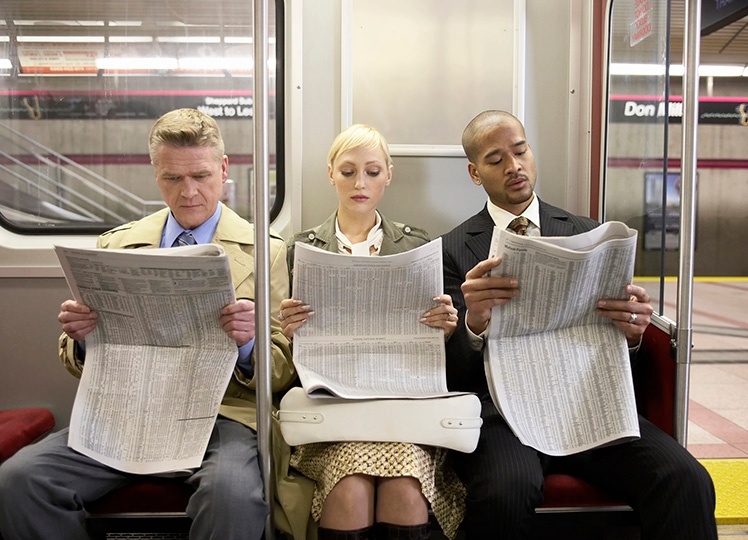There are so many public transportation myths floating around. So, to set the record straight once and for all, we’ve decided to separate fact from fiction.
Myth: Public transportation only benefits those who actually use it.
Fact: Public transportation actually benefits the whole community, and in more ways than one.
For starters, public transportation systems reduce congestion on the roads. So for those of you who live in densely-populated areas where public transportation is aplenty, your rush hour traffic could be much much much worse. You shudder at the thought, right? Well, here are some interesting stats:
According to The American Public transportation Association (APTA), “Americans living in areas served by public transportation save 646 million hours in travel time and 398 millions of fuel in congestion reduction.”
Myth: Transit is subsidized; whereas, roads and highways are paid for entirely by their users.
Fact: Both are actually subsidized. It takes a lot more than just gasoline taxes and vehicle registration fees to cover the costs of building, operating, and even maintaining your roads. That money has to come from somewhere.
Myth: People are not taking public transportation anymore. Everyone knows that.
Fact: We beg to differ. National transit stats are actually on the rise. According to American Public Transportation Association (APTA), in 2011, Americans took 10.4 billion trips on public transportation, and in 2012, that number increased by a whopping 154 million to a grand total of 10.5 billion. People are taking public transportation, and they’re riding it in spades.
Myth: Well, I don’t live in a big city, like New York, so I can’t rely on public transportation anyway.
Fact: That’s so not true! Many states are really stepping up their public transportation systems. Take Pennsylvania for instance. In November 2013, state legislation approved a $2.3 billion transportation funding bill that will not only go towards fixing up highways and bridges, but a portion of that money will also aid in sprucing up their state’s many mass transit systems.
Even smaller cities are working on increasing public transportation options. The City of Houston opened an a new light rail extension in 2013 and has two other lines under construction.
Myth: I already have a flexible spending account (FSA), so I can just use that to pay for my commuting costs.
Fact: Actually, IRC Section 125, which covers both cafeteria plans and flexible spending accounts, doesn’t include commuter benefits. You can’t use funds in your FSA to pay for commuting costs.
Myth: Come on, public transportation really doesn’t get that many cars off the road.
Fact: Indeed it does. According to the Virginia Department of Rail and Public Transportation, just one commuter railcar gets about 125 cars off the road. Each bus helps alleviate congestion, too, by getting about 35 cars off the road.
Myth: Commuting by public transportation won’t cut down on my commute time. It would probably be faster if I just drove to work.
Fact: This one is a bit tricky because it depends on a bunch of different factors, like location and traffic congestion. If you’re commuting to work in a suburban area where traffic congestion isn’t all that terrible, it might be a bit faster to drive. But, if you’re commuting in a jam-packed city, like New York or Boston, taking public transportation will save you time, not to mention a bit of stress.
Driving in rush hour can make the calmest, most patient person in the world bristle with annoyance. If you’re on the bus or train at least you can read or play Candy Crush on your phone instead of trying to suppress the major road rage you’re feeling at the guy in the Beemer who just cut you off.
Myth: Well, I live in the suburbs, and public transportation doesn’t serve the suburbs.
Fact: Lots of suburban areas have pretty decent public transportation, and many more are finding ways to expand city service into the ‘burbs. Just look at New Jersey’s MCAT: Middlesex County Area Transit.
This transit service serves the large suburban area quite well. Those who live in the suburbs of Chicago can usually find a Metra station nearby, which will take them right into the city. Chicago suburbanites can also check into Pace, a bus service that provides transportation to and around the city’s many suburban areas.
Myth: Public transportation isn’t safe; there’s way too much crime at the stations or even while riding the train.
Fact: Sadly, crime is a problem everywhere. But, some cities have actually seen a decrease in crime in their stations or on their buses and trains, especially New York City.
Thefts, robberies, and assaults have dropped 16% since 2012 in the Big Apple. Chicago’s CTA has had less crime as well. In fact, violent crime on the CTA went down 19% in 2012 due to an increased police presence. Still not convinced? Check out our public transit safety tips.
Myth: Public transportation costs more than it should.
Fact: While it may cost money to run and maintain public transportation, it’s actually good for the economy. Here are some interesting figures from APTA:
- • Every dollar communities invest in public transportation generates approximately $4 in economic returns.
- • Every $1 billion invested in public transportation supports and creates 36,000 jobs.
- • Every $10 million in capital investment in public transportation yields $30 million in increased business sales.
- • Every $10 million in operating investment yields $32 million in increased business sales.
What wild tales have you heard about public transportation?
Since you are here, keep reading and learn how you can save on public transportation with commuter benefits.

